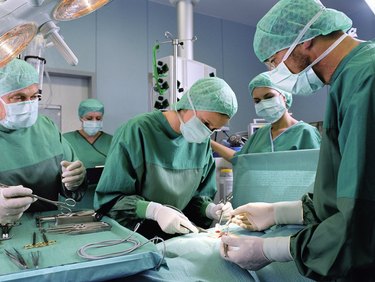
Hyperthyroidism and cancerous or non-cancerous tumors of the thyroid gland often require a thyroidectomy or removal of the gland. Because of its location at the base of the neck, this surgery can affect what you can eat during the healing process. Removal of this gland will not require you to make any permanent changes to your diet though the increased metabolism created by an overactive thyroid gland might have resulted in weight loss. Post-surgery, you are susceptible to gaining some of that weight back. Hormone replacement therapy will help keep your metabolism at a normal level but you want to make sure you eat a healthy diet in the long-term to minimize unwanted weight gain.
Timeframe
Video of the Day

The healing process can vary from person to person and no exact set time exists for modifying your diet. It can take up to a couple of weeks to feel completely better after a thyroidectomy says Cancer Research UK. This means you might have to modify your diet for at least this long.
Video of the Day
Liquids and Soft Foods

Georgetown University Hospital advises you to stick to liquids and soft foods only for the first few days after surgery, though you might require this type of diet longer as mentioned above.
Good choices include water, juice, mashed vegetables and potatoes, ice cream, pudding, milk shakes, eggs, broth, pasta, chile, beans, hummus, salsa, guacamole, tender meats, fish and gelatin. If coughing after consuming the foods becomes a problem, try thicker consistency items.
Tips

Drink plenty of fluids during and after meals. Soften foods with gravy and sauces. Eat slowly. Put solid foods in a blender to make them easier to eat. A soft diet can sometimes pose problems in terms of getting enough calories. You can boost calorie intake in several ways including adding cheese to soups and stews, mixing in butter and milk with mashed vegetables and potatoes, adding beans and lentils to soups and stews, eating vegetables with dips like hummus or sour cream and adding whey protein or breakfast drink mix to milkshakes.
Considerations

If you find eating painful, talk to your doctor about ways to combat this. He might prescribe pain medications to make eating easier. You might also consider consulting with a dietitian who can help you design an eating plan while you heal.